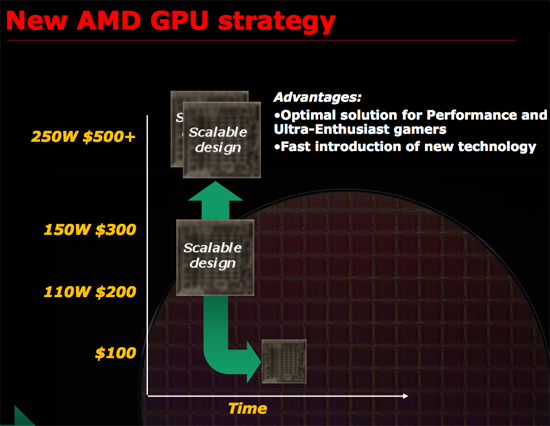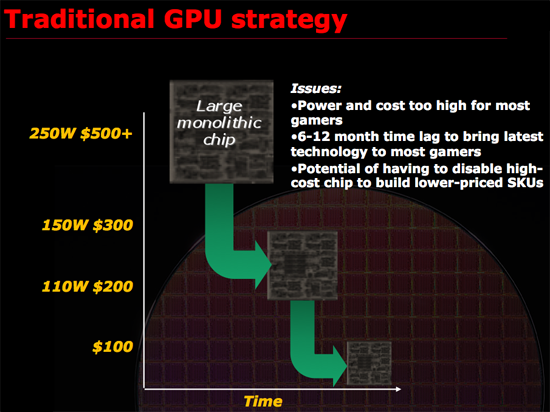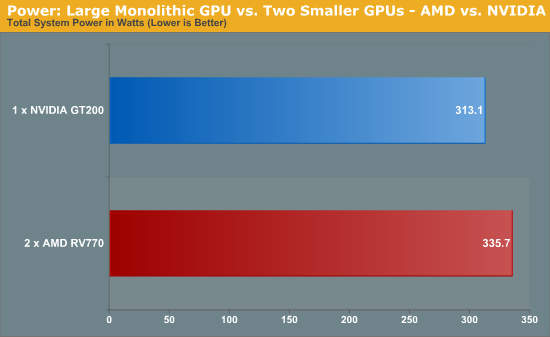ATI Radeon HD 4850 Preview: AMD Delivers Performance for the Masses
by Anand Lal Shimpi & Derek Wilson on June 19, 2008 5:00 PM EST- Posted in
- GPUs
AMD: The Peoples' GPU Maker
This week AMD came out and codified its new GPU strategy, but in reality it's the same strategy that has been in place since the release of the R600 GPU (Radeon HD 2900 XT). On paper (or LCD), it's the best idea ever, take a look:

Obviously this mythical GPU that can let you play at any resolution with any detail settings doesn't exist, but the idea is that AMD will continue to target the $200 - $300 market segment with its GPU designs.

The buck doesn't stop there though, AMD will continue to build more and less expensive GPUs, they will simply be derived off of this one mainstream design. Again this is nothing new, it's exactly what AMD did with R600 and RV670.
NVIDIA's approach is markedly different as this week's GT200 launch clearly illustrates. NVIDIA continues the approach of building a very large, monolithic GPU, eventually scaling the architecture down to lower power and price points. The GT200 is the latest example of the large monolithic die and subsequent mainstream parts will be based on some version of that GPU.

AMD argues that NVIDIA's approach means that there's too long of a time to market for high speed mainstream GPUs and it keeps power/costs high. There is truth in what AMD is saying but not entirely.
NVIDIA could just as easily introduce a brand new architecture with a mainstream part, it simply chooses not to as it's far easier to recoup R&D costs by selling ultra high end, high margin GPUs.
The power/cost argument is a valid one but AMD's approach isn't actually any better from that standpoint:

A pair of RV770s, AMD's new GPU, end up consuming more power than a single GT200 - despite being built on a smaller 55nm process.
A pair of these RV770s only costs $400 compared to $650 for a single GT200, but I suspect that part of that is due to differences in manufacturing process. If NVIDIA hadn't been so risk averse with the GT200 and built it on 55nm (not that I'm advocating it, simply posing a hypothetical), the cost differences would be smaller - if not in favor of NVIDIA since GT200 is built on a single card.
When the smoke clears, AMD's strategy is to simply build a GPU for the masses and attempt to scale it up and down. While NVIDIA is still building its GPUs the same way it has for decades, starting very large and scaling down.
AMD isn't taking a radically different approach to building and designing GPUs than NVIDIA, it's simply building one market segment lower.










114 Comments
View All Comments
docmilo - Thursday, June 19, 2008 - link
I browsed on over to the Egg and did a search on 4850. A whole bunch of cards popped up at $199.99 and one even has a rebate! I wonder how long until it stops saying "Buy Now" and goes to "Autonotify".chizow - Thursday, June 19, 2008 - link
You guys did a nice job of covering both the pros and cons of the 4850 and CF, showing some of the pitfalls of relying on multi-GPU solutions for performance. You also made mention that similar performance gains were seen long ago with the 8800GT.That said the 4850 is certainly a good part from AMD and there's definitely some very interesting things they've done with this card. You hinted at a lot of them with the architectural changes but there's a few other sites that hinted at some of the changes. Its clear ATI has drastically improved their memory controllers and cache design along with their render back ends for AA performance.
I think the real thing to keep an eye on though is how AMD managed to get near 100% scaling with CF. Extremetech hinted at improved memory controllers and a gpu communications "Hub" here http://www.extremetech.com/article2/0,2845,2320865...">http://www.extremetech.com/article2/0,2845,2320865... for improved performance between GPUs. I'm sure you guys will cover these improvements in detail in your complete review, but it looks like that hyper transport mechanism you alluded to.
MadBoris - Thursday, June 19, 2008 - link
Nice to see AMD staying competitive, plus keeping prices down.I think the days of me spending $400+ on a video card are behind me, atleast for the foreseeable future. You have to provide alot more than 10% performance increases for an extra $250 NVIDIA.
I'm rather surprised NVIDIA has not really capitalized on taking a huge performance lead and crown with all the AMD post merger dust settling.
I'm pleasantly surprised that AMD is continuing to excel with HW. If only they would bring back an AIW card, I'd buy one, but my current 8800GTS is not so outmatched that it is worth upgrading to anything this generation.
Good article Anand.
fungmak - Thursday, June 19, 2008 - link
Looking at the CF perfomance of other sites who used cat 8.6, IIRC were a lot better than the current AT results.Just wondering if there is an intention to update using cat 8.6?
derek85 - Friday, June 20, 2008 - link
I second this, I'm sure 8.6 came with some nice optimizations on 770s.DerekWilson - Friday, June 20, 2008 - link
we did not use catalyst 8.5 drivers.we used the very latest beta drivers ATI could get us.
Wirmish - Friday, June 20, 2008 - link
And did you use the Radeon HD 4800 Series Hotfix (6/20/2008) ?http://support.ati.com/ics/support/default.asp?dep...">http://support.ati.com/ics/support/default.asp?dep...
;)
Nighteye2 - Thursday, June 19, 2008 - link
The big question for the comparison between this card in CF and the GT200 will not be the classic framerates here - but the performance of games that use the GPU for part of the physics processing. The GT200 has lots of compute power to spare for physics, can 2 4850's in CF match that?FITCamaro - Friday, June 20, 2008 - link
With 800 shaders it wouldn't surprise me.Wirmish - Friday, June 20, 2008 - link
He talk about CF...So it's 1600 shaders !